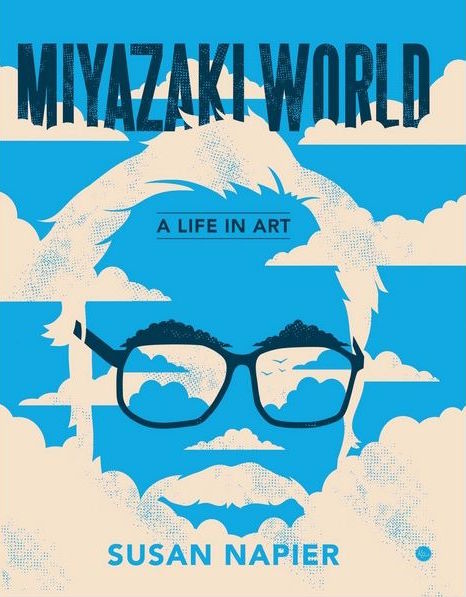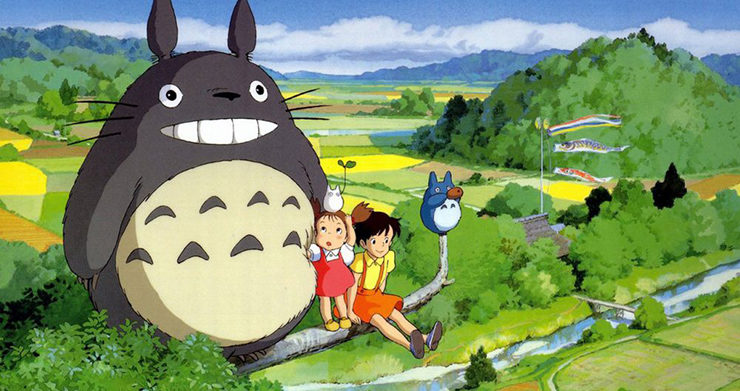I love Studio Ghibli’s films. Repeated viewings of My Neighbor Totoro and Kiki’s Delivery Service were all that got me through college with my mind (more or less) intact. But more to the point, I love Hayao Miyazaki. I love that he obsesses about his work, makes absurdly detailed films, never stops at good enough. I love that he’s prickly and irascible in interviews. I love that he constantly harps on how much better things were when it seemed like his generation were going to turn Japan socialist. I love how he’s unafraid of an ambiguous ending, and indeed, seems to regard happy endings with suspicion—but that he’s also willing to lay pure joy on us and expect us to keep up.
All of these elements are discussed in Susan Napier’s MiyazakiWorld, a masterful look at his life and career that balances the best elements of pop culture enthusiasm and academic analysis.
Susan Napier is the Goldthwaite Professor of Rhetoric at Tufts University. She focuses on Japanese culture, particularly film and anime, and her previous books include Anime from Akira to Howl’s Moving Castle: Experiencing Japanese Animation and The Subversion of Modernity: the Fantastic in Modern Japanese Literature. Here she dives into the life and work of Hayao Miyazaki specifically, giving us brief moments of biography interspersed with longer looks at each of his films.
Napier begins with Miyazaki’s childhood, and how living through World War II as a privileged child shaped his later anti-authoritarian beliefs. He realized, looking back, that he had a much better time during the war than much of his generation, and so often dealt with themes of war and aggression in his films. She digs into his complicated legacy as the son of war profiteers—Miyazaki’s grandfather, father, and uncle headed up a factory that made fan belts for Zeros, thus directly benefiting from Japan’s war effort, and allowing young Miyazaki the luxury of a suburban home and garden, far from the horrors his future partner Isao Takahata experienced, for instance. The war and his family’s role in it fed directly into the tension between his love of planes and flight, so beautifully expressed in his films, and his horror of war. Napier repeatedly returns to one pivotal moment in Miyazaki’s childhood: in the last month of the war, when Miyazaki was four years old, an air raid devastated his neighborhood. Napier quotes Miyazaki’s biographer, Ōizuma, to relate what happened next:
My uncle came by with a company truck, smaller than the vehicles that we have these days; the space for luggage was really tiny…the streets that he passed along were burning, right down to the sides of the road. …We covered ourselves with a blanket—we had to somehow get through the place where the flames were burning.
Just then at the guard rail a bunch of people arrived looking for shelter. My memory isn’t totally clear on his, but I’m certain that I heard a woman’s voice saying, “Please let us on.” I’m not sure if it was my memory or if I heard it from my parents and felt like I had seen it, but, anyway it was a woman carrying a little girl, someone from the neighborhood running toward us saying, “Please let us on!” But the car just went on going. And the voice saying, “Please let us on” got father away and it gradually took root in my head the way a traumatic event does.
In Napier’s view this moment became one of the roots of what she calls ‘Miyazakiworld’ as the director used his work to revisit his feeling of terror and helplessness, repeatedly giving his child heroes moments of strength where they can subvert or challenge uncaring adults, and creating adult heroes who value compassion above all else. Nausicaä, Kiki, Ashitaka, Chihiro, hell, even Miyazaki’s version of Lupin III—all of them would have stopped to save the mother and child. At the same time, the director is not naive or sentimental. In his world, war is often a reality to be reckoned with–the trick is in finding a way to keep your humanity and sense of decency intact. With Lady Eboshi, he gives us a character who makes plenty of moral compromises, but who also defends the helpless. In Howl, he gives us a magical terrorist who risks himself nightly to stop a ceaseless battle. In Jiro he gives us a romantic whose love of flight is perverted into an instrument of destruction. But around these characters he also allows for pure whimsy and magic, which is the key to Miyazakiworld.
In Miyazakiworld, Nausicaä can find delight in exploring a toxic jungle. Kiki can enter a dark wood, and instead of a witch or haunted house find a young artist who becomes a new friend. Miyazakiworld has enough room for the awe-inspiring Deidarabotchi and the cute kodama. A man can reject his humanity and be cursed to live as a pig (maybe) but everyone else in his life will simply accept him as a pig, no one will make a big deal about it, and he can then take refuge in his pig-ness when humans disgust him by embracing fascism.
Napier gives us an in-depth look at each of Miyazaki’s films, pulling out examples of this loose, beautiful universe and looking at recurring themes in the works. She draws links between Totoro and Kiki as two different views of Japan’s 1980s bubble economy: Totoro gives us a more negative view, where people exhausted by the excesses of capitalism wanted to flee to an agrarian past and celebrate a small rural community that lives in harmony with nature. On the other hand, in Kiki’s Delivery Service she sees the connection between the film’s message of a young witch’s independence, and the shift in society that happened when young women entered Japan’s workforce, living independently, saving up for European vacations, and generally demanding a level of autonomy that hadn’t been common before. And of course in Spirited Away, we see what happens after the bubble bursts.
In an inspired reading, Napier shows how Spirited Away and Howl’s Movie Castle can also serve as meta-commentaries on Studio Ghibli itself, with Yubaba’s bathhouse and Howl’s ramshackle castle as giant, fractious collectives fueled by near-constant work and many different personalities that barely hold everything together. She looks at the links between Miyazaki’s own mother, a towering, forceful woman even as she battled tuberculosis, and Miyazaki’s love for strong-willed girls and imperious older women, and she refracts Porco Rosso through the lens of Miyazaki’s mid-40’s, but she never resorts to easy pop psychoanalysis.
Buy the Book


Miyazakiworld: A Life in Art
In what is probably the best thread in the book, Napier carefully explores the political and environmental themes in each of Miyazaki’s films. She looks at how they’re infused with Miyazaki’s political beliefs—not in the manner of a tract or propaganda, but in the clear-eyed way that he looks at all sides of a question in his films. As she shows, Miyazaki often comes down on the side of nature, even if it means the destruction of humanity. Napier takes special care with his two masterworks, Nausicaä of the Valley of the Wind and Mononoke Hime. First she talks about key differences between the Nausicaä film that Miyazaki made in 1984 and the ongoing manga that he wrote and drew between 1982 and 1994, looking specifically at how the film’s optimistic ending diverges from the manga’s resolution, which implies that a new world is indeed being born from the ashes of human civilization, but makes no promises that humans can live in it.
This is echoed in her later discussion of Mononoke Hime, where she looks at how Miyazaki creates moments of utterly non-human transcendence. The Shishigami might be able to cure Ashitaka, but it doesn’t particularly care about him. It is not a benevolent, anthropomorphic god who concerns itself with the lives of humans. It simply is. It receives worship from the kodama and other forest creatures, but doesn’t seem to dole out any favors or theology. It can be hurt, but it can also heal itself and the land to some extent. It doesn’t care that the Emperor wants its head, because it doesn’t care that there’s an Emperor. An aspect of Shishigami will exist long after the Emperor is dust. This sense of otherworldly, non-human-centric awe is a huge part of Miyazakiworld as Napier sees it. The constant refrain of wind currents, the lives of animals, and the cycles of nature surround the mortal humans and their slightly less mortal gods, and will outlast all of them.
MiyazakiWorld is a fantastic work of film scholarship that underlines just how titanic an achievement Miyazaki’s filmography is. As Napier finds themes that echo across all of his work, you will probably find yourself saying, as I did: “OK, this one’s my favorite. Oh, but, no, it’s gotta be Totoro. But wait, what about that one? Oh, I forgot Porco Rosso…”
Leah Schnelbach knows that as soon as this TBR Stack is defeated, another shall rise in its place, and she’d still rather be a pig than a fascist. Come sing the Totoro song with her on Twitter!










